Do Locations of Employment and Residence Influence whether People Use Virtual Social Networks? A Case Study of Residents in Wuhan, China
Abstract
:1. Introduction
- Research question 1 (RQ1): Are there geospatial characteristics in the distribution of VSA users’ occupational or residential locations?
- Research question 2 (RQ2): If the answer to RQ1 is positive, what are the specific manifestations of the geospatial characteristics?
- Research question 3 (RQ3): If the answer to RQ2 is obvious, what are the effects of traditional social environments on the geospatial characteristics?
2. Literature Review
3. Materials and Methods
3.1. Case Study
3.2. Dataset
3.3. Methods
3.3.1. Spatial Autocorrelation
3.3.2. Regression Models
4. Results
4.1. The Distribution of VSA Users by Locations of Residence and Employment
4.2. Differences between the Urban and Suburban Locations of Residence and Employment of VSA Users
4.3. The Effect of Traditional Social Convenience on the Differences between Urban and Suburban Locations of Residence and Employment of VSA Users
5. Discussion and Conclusions
Author Contributions
Funding
Data Availability Statement
Conflicts of Interest
References
- Loo, B.P.Y. The E-Society; Nova: New York, NY, USA, 2012. [Google Scholar]
- Sgroi, D. Social network theory, broadband and the future of the World Wide Web. Telecommun. Policy 2008, 32, 62–84. [Google Scholar] [CrossRef]
- Tian, L.; An, J. The Effect of Network Social Interaction on Real Life Interpersonal Communication. Libr. Inf. Serv. 2013, 57, 13–19. [Google Scholar]
- Shi, Y.Y.; Song, Y.P. Familiar Stranger: Community Interpersonal Relations and Mobilization Strategies under the Background of Network Social Communication. Hubei Soc. Sci. 2021, 13, 42–48. [Google Scholar] [CrossRef]
- Zhang, L. The Impact of Social Media on Interpersonal Relationships—A Brief Analysis of the Relationship from Acquaintance to Stranger. J. News Res. 2017, 8, 102+254. [Google Scholar]
- Liu, Z.; Chen, Y. On the Establishment, Use and Significance of Social Platform for Strangers. J. News Res. 2021, 12, 51–53. [Google Scholar]
- Lei, Z. The New Development of the Stranger Theory in the Contemporary Era: Stranger Social Groups and Stranger Society. Sci. Educ. Artic. Collect. 2018, 37–39. [Google Scholar] [CrossRef]
- Tan, Y.M.; Chai, Y.W.; Guan, M.P. The impact of the uncertain geographic context on the space-time behavior analysis: A case study of Xining, China. Acta Geogr. Sin. 2017, 72, 657–670. [Google Scholar]
- Cairncross, F. The Death of Distance: How the Communications Revolution Will Change Our Lives; Harvard Business School Press: Boston, MA, USA, 1997. [Google Scholar]
- Ōmae, K. The Borderless World: Power and Strategy in the Interlinked Economy; Revised edition; HarperBusiness: New York, NY, USA, 1999. [Google Scholar]
- Wang, Z.; Yun, Y.; Cheng, H. The Spatial Characteristics and its Impact Mechanism of Urban Residential Mobility: Based on Micro Survey Data of Tianjin. Urban Dev. Stud. 2018, 25, 107–115. [Google Scholar]
- Ballatore, A.; De Sabbata, S. Los Angeles as a digital place: The geographies of user-generated content. Trans. GIS 2020, 24, 880–902. [Google Scholar] [CrossRef]
- Li, L.N.; Goodchild, M.F.; Xu, B. Spatial, temporal, and socioeconomic patterns in the use of Twitter and Flickr. Cartogr. Geogr. Inf. Sci. 2013, 40, 61–77. [Google Scholar] [CrossRef]
- Andreev, P.; Salomon, I.; Pliskin, N. Review: State of teleactivities. Transp. Res. Part C Emerg. Technol. 2010, 18, 3–20. [Google Scholar] [CrossRef]
- Huberman, B.; Romero, D.M.; Wu, F. Social networks that matter: Twitter under the microscope. First Monday 2008, 14. [Google Scholar] [CrossRef]
- Lerman, K.; Ghosh, R. Information Contagion: An Empirical Study of the Spread of News on Digg and Twitter Social Networks. In Proceedings of the International AAAI Conference on Web and Social Media, Washington, DC, USA, 23–26 May 2010. [Google Scholar]
- Sakaki, T.; Okazaki, M.; Matsuo, Y. Earthquake Shakes Twitter Users: Real-Time Event Detection by Social Sensors. In Proceedings of the 19th International Conference on World Wide Web, WWW 2010, Raleigh, NC, USA, 26–30 April 2010. [Google Scholar]
- Bollen, J.; Mao, H.; Zeng, X. Twitter mood predicts the stock market. J. Comput. Sci. 2011, 2, 1–8. [Google Scholar] [CrossRef]
- Bernabeu-Bautista, Á.; Serrano-Estrada, L.; Perez-Sanchez, V.R.; Martí, P. The Geography of Social Media Data in Urban Areas: Representativeness and Complementarity. ISPRS Int. J. Geo-Inf. 2021, 10, 747. [Google Scholar] [CrossRef]
- Uskuplu, T.; Terzi, F.; Kartal, H. Discovering Activity Patterns in the City by Social Media Network Data: A Case Study of Istanbul. Appl. Spat. Anal. Policy 2020, 13, 945–958. [Google Scholar] [CrossRef]
- Ebrahimpour, Z.; Wan, W.; Velázquez García, J.L.; Cervantes, O.; Hou, L. Analyzing Social-Geographic Human Mobility Patterns Using Large-Scale Social Media Data. ISPRS Int. J. Geo-Inf. 2020, 9, 125. [Google Scholar] [CrossRef]
- Goldenberg, J.; Levy, M. Distance Is Not Dead: Social Interaction and Geographical Distance in the Internet Era. arXiv 2009, arXiv:0906.3202. [Google Scholar]
- Thulin, E.V.A.; Vilhelmson, B. Virtual mobility of urban youth: ICT-based communication in sweden. Tijdschr. Voor Econ. En Soc. Geogr. 2005, 96, 477–487. [Google Scholar] [CrossRef]
- Wang, B.; Zhen, F.; Xi, G. A study of cybergeography based on micro-blog users’ relationship: With a case of Sina micro-blog. Geogr. Res. 2013, 32, 380–391. [Google Scholar]
- Sharmeen, F.; Arentze, T.; Timmermans, H. Dynamics of face-to-face social interaction frequency: Role of accessibility, urbanization, changes in geographical distance and path dependence. J. Transp. Geogr. 2014, 34, 211–220. [Google Scholar] [CrossRef]
- Wang, Z.; Zhang, F.; Wu, F. Intergroup neighbouring in urban China: Implications for the social integration of migrants. Urban Studies 2015, 53, 651–668. [Google Scholar] [CrossRef]
- Amin, A.; Thrift, N. Cities: Reimagining the Urban; Polity Press: Cambridge, UK, 2002. [Google Scholar]
- Whyte, M.K.; Parish, W.L. Urban Life in Contemporary China; University of Chicago Press: Chicago, IL, USA, 1986; Volume 91, pp. 988–990. [Google Scholar] [CrossRef]
- Perlstadt, H. To dwell Among Friends: Personnal Networks in Town and City, Claude, S. Fischer, Chicago: University of Chicago Press, 1982. 451 pp. with methodological appendix. $22.50 (hardback). Urban Life 1984, 12, 479–482. [Google Scholar] [CrossRef]
- Tillema, T.; Dijst, M.; Schwanen, T. Face-to-face and electronic communications in maintaining social networks: The influence of geographical and relational distance and of information content. New Media Soc. 2010, 12, 965–983. [Google Scholar] [CrossRef]
- Forrest, R.; Yip, N.-M. Neighbourhood and Neighbouring in Contemporary Guangzhou. J. Contemp. China 2007, 16, 47–64. [Google Scholar] [CrossRef]
- Hazelzet, A.; Wissink, B. Neighborhoods, Social Networks, and Trust in Post-Reform China: The Case of Guangzhou. Urban Geogr. 2012, 33, 204–220. [Google Scholar] [CrossRef]
- Anderson, W.P.; Chatterjee, L.; Lakshmanan, T.R. E-commerce, transportation, and economic geography. Growth Chang. 2003, 34, 415–432. [Google Scholar] [CrossRef]
- Krizek, K.J.; Li, Y.; Handy, S.L. Spatial attributes and patterns of use in household-related information and communications technology activity. Transp. Res. Rec. 2005, 1926, 252–259. [Google Scholar] [CrossRef]
- Etminani-Ghasrodashti, R.; Hamidi, S. Online shopping as a substitute or complement to in-store shopping trips in Iran? CITIES 2020, 103, 102768. [Google Scholar] [CrossRef]
- Farag, S.; Weltevreden, J.; van Rietbergen, T.; Dijst, M.; van Oort, F. E-Shopping in the Netherlands: Does Geography Matter? Environ. Plan. B Plan. Des. 2006, 33, 59–74. [Google Scholar] [CrossRef]
- Shi, X.; Wang, S.J.; Hao, F.L.; Wang, D.Y. Spatial diffusion and penetration about the takeaway 020 e-commerce in China: Feasibility of innovation diffusion hypothesis and efficiency hypothesis. Geogr. Res. 2021, 40, 1338–1353. [Google Scholar]
- Shi, K.B.; Yang, Y.C.; Shao, R.; Li, E.L.; Zhang, W.; Yuan, T. Analysis on the Spatial Characteristics of C2C Network Consumption of Urban Residents in China—The Applicability of technology diffusion and efficiency hypothesis. Sci. Geogr. Sin. 2019, 39, 107–115. [Google Scholar] [CrossRef]
- Wang, M.F.; Lu, S.; Yuan, H. Influences of Online Shopping on Consumer Behaviors at Different Shopping Locations: A Comparative Study on City Center and Subur. City Plan. Rev. 2013, 37, 84–88+95. [Google Scholar]
- Xi, G.L.; Zhen, F.; Wang, X.; Qin, X. Study on the influencing factors and spatial characteristics of residents’ online consumption in Nanjing. Geogr. Res. 2014, 33, 284–295. [Google Scholar]
- Huang, R.; Sun, X. Weibo network, information diffusion and implications for collective action in China. Inf. Commun. Soc. 2014, 17, 86–104. [Google Scholar] [CrossRef]
- Dekker, R.; Engbersen, G.; Faber, M. The Use of Online Media in Migration Networks. Popul. Space Place 2016, 22, 539–551. [Google Scholar] [CrossRef]
- Salomon, I. Telecommunications and travel relationships: A review. Transp. Res. Part A Gen. 1986, 20, 223–238. [Google Scholar] [CrossRef]
- Handy, S.; Yantis, T. The Impacts of Telecommunications Technologies on Nonwork Travel Behavior; Southwest Region University Transportation Center, Center for Transportation Research: Austin, TX, USA, 1997. [Google Scholar]
- Liu, Z.B.; Zhang, C.; Dai, T.Q. Measuring Accessibility of Multi-Type Urban Public Service Facilities with Entropy in Beijing. Econ. Geogr. 2018, 38, 77–84. [Google Scholar] [CrossRef]
- Shi, T.M.; Bu, Y.J.; Shi, Y. Research on the Spatial Pattern of Urban Living Service Facility in Shenyang Based on POl Data. J. Shenyang Jianzhu Univ. (Soc. Sci.) 2021, 23, 217–224. [Google Scholar]
- Li, X.; Fong, P.S.W. Research on Evaluation and Countermeasures for Informatization Development of Smart Wuhan Based on Wavelet Aeural Network. Inf. Sci. 2018, 36, 113–117. [Google Scholar] [CrossRef]
- Fan, H.Q. The New Strategy and Journey of China Unicom in 2021. Commun. World 2021, 24, 45–46. [Google Scholar] [CrossRef]
- Niu, Q.; Zhang, H.; Wu, L.; Zou, W. Urban-suburban heterogeneity of mobile office development in recent years: Based on mobile office app usage big data of China Unicom users in Wuhan in 2019 and 2021. Prog. Geogr. 2022, 41, 1428–1439. [Google Scholar] [CrossRef]
- Wang, D.; Zhu, L.; Yan, L. The Characteristics of the Use of Mobile Internet and the Comovement between Physical and Virtual Spaces. J. Tongji Univ. (Soc. Sci. Ed.) 2022, 33, 56–66+77. [Google Scholar]
- CNNIC. The 48th Statistical Reports on Internet Development in China; China Internet Network Information Center: Beijing, China, 2021. [Google Scholar]
- Zeng, Y.G. Returning from the strange society to the acquaintance society: The new circle culture in WeChat. Explor. Free. Views 2017, 7, 49–52. [Google Scholar]
- Fang, N. The “New Differential Order Pattern” in the Internet Era—The Change and Reorganization of Social Structure and Relationship Patternin WeChat Circle Field. J. Hebei Univ. Sci. Technol. (Soc.) 2020, 20, 36–42. [Google Scholar]
- Jing, M.; Zhu, Y.D.; Feng, X.Y. Research on the Generation Model of Opinion Leaders’ Influence in Weibo. J. Res. 2021, 1–13+119. [Google Scholar]
- Zhang, W.H.; CHen, J.J.; Yang, Z.P. An Empirical Study on the Influence of Opinion Leaders on Consumers’ Consumption Intention in “Live Delivery”. China Collect. Econ. 2022, 6, 82–84. [Google Scholar]
- ZHao, X.Q.; Wang, Q.Q.; Cai, Q. Analysis of Knowledge Sharing Behavior Characteristics of Opinion Leaders in Online Q&A Community—Taking the topic of “Travel” in Zhihu as an example. Inf. Sci. 2021, 39, 68–74. [Google Scholar] [CrossRef]
- Xie, Z.; Zhen, F.; Zhang, S. Research on Spatial Characteristics and Influencing Factors of Urban Employment Based on Big Data. Urban Dev. Stud. 2021, 28, 48–57+42+181. [Google Scholar]
- Oldenburg, R.; Brissett, D. The third place. Qual. Sociol. 1982, 5, 265–284. [Google Scholar] [CrossRef]
- Wu, S.T.; Feng, Y.K.; Wu, Q. Research on planning strategies of the third place vitality promotion in winter cities. Low Temp. Archit. Technol. 2022, 44, 18–23. [Google Scholar] [CrossRef]
- Wang, J.Y.; Chang, S.Z. Research on Evaluation and Delineation of 15-min Community Life Circle for Planning Implementation. Geospat. Inf. 2022, 20, 24–27. [Google Scholar]
- Moran, P.A. Notes on continuous stochastic phenomena. Biometrika 1950, 37, 17–23. [Google Scholar] [CrossRef]
- Wang, S.; Noland, R.B. Variation in ride-hailing trips in Chengdu, China. Transp. Res. Part D Transp. Environ. 2021, 90, 102596. [Google Scholar] [CrossRef]
- Brunsdon, C.; Fotheringham, A.S.; Charlton, M.E. Geographically Weighted Regression: A Method for Exploring Spatial Nonstationarity. Geogr. Anal. 1996, 28, 281–294. [Google Scholar] [CrossRef]
- Golob, F.T. A Model of Household Demand for Activity Participation and Mobility; The University of California Transportation Center, University of California at Berkeley: Berkeley, CA, USA, 1996; Volume 335, p. 40. [Google Scholar]
- Senbil, M.; Kitamura, R. Simultaneous Relationships between Telecommunications and Activities. In Proceedings of the Tenth International Conference on Travel Behaviour Research, Lucerne, Switzerland, 10–15 August 2003. [Google Scholar]
- Yin, L.L. Telephone real-name registration system and Legal Protection of Personal Information. Leg. Vis. 2018, 180. [Google Scholar]
- Niu, Q.; Zhu, Y.R.; Jiang, Y.X.; Wu, L.; Gu, C.T. Trends, Characteristics of Online and Offline Urban Activities and lts Impacts on Cities. Urban Dev. Stud. 2021, 28, 45–54. [Google Scholar]
- Cai, J.; Kwan, M.-P. Discovering co-location patterns in multivariate spatial flow data. Int. J. Geogr. Inf. Sci. 2022, 36, 720–748. [Google Scholar] [CrossRef]

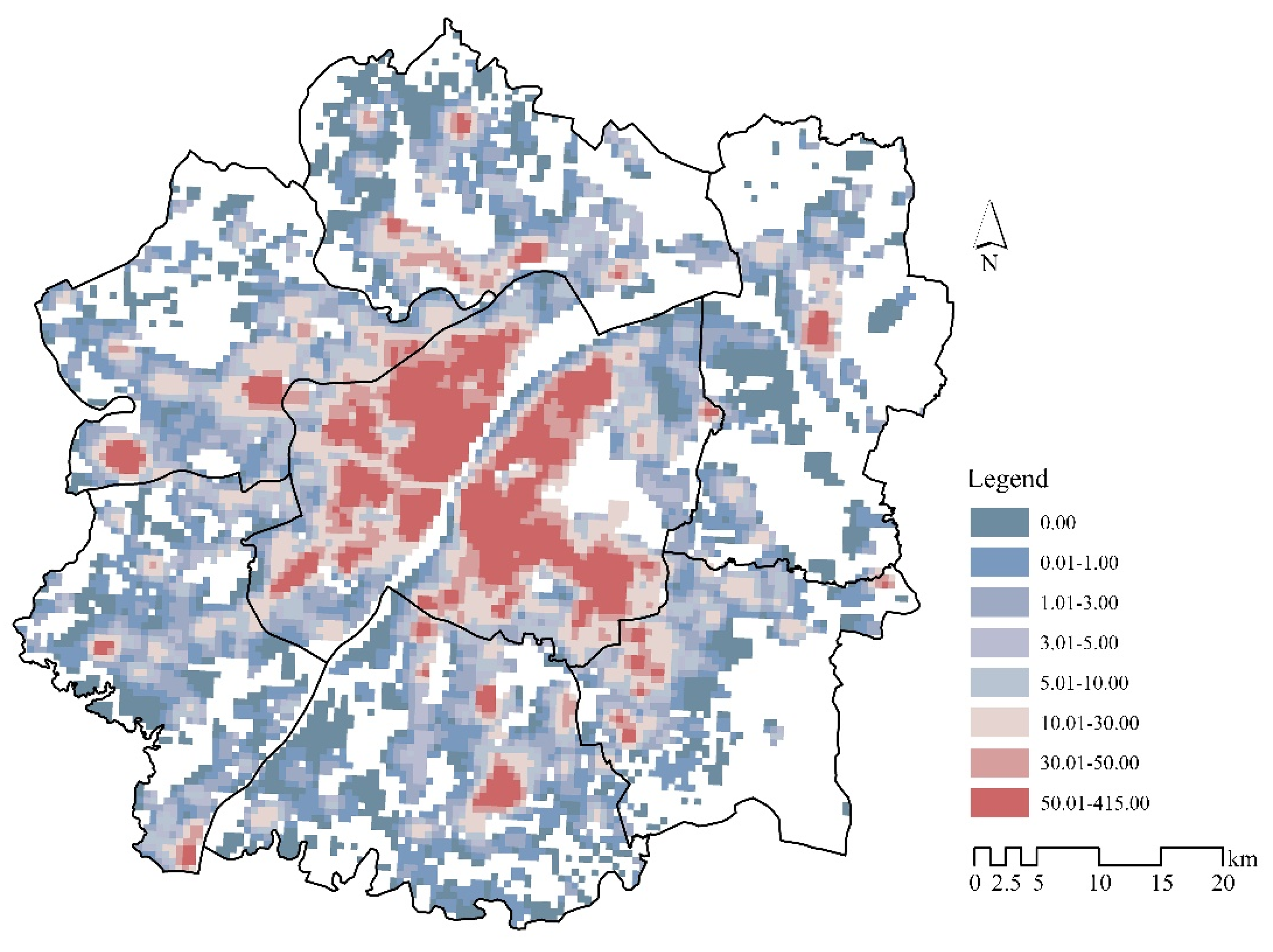
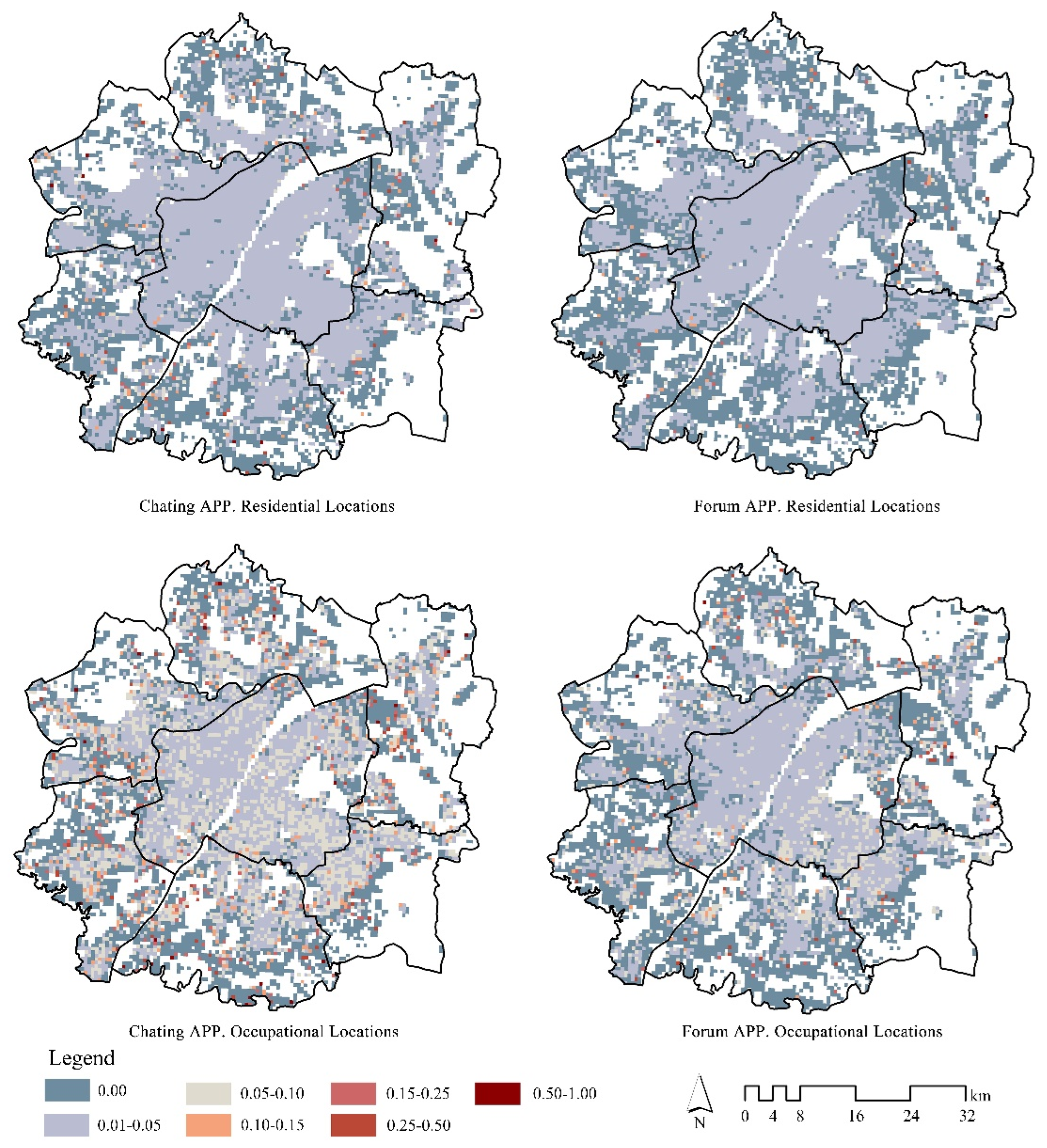
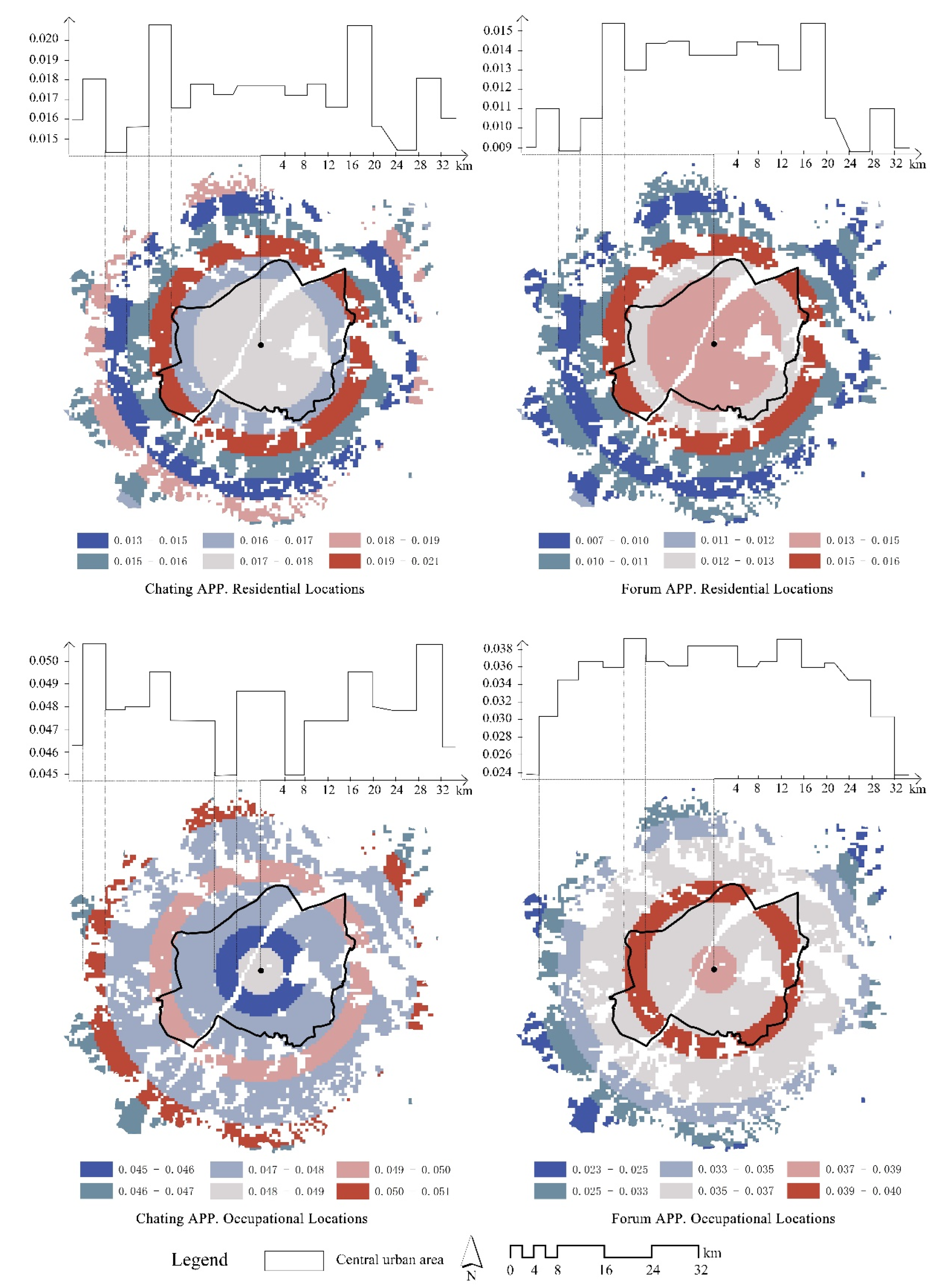
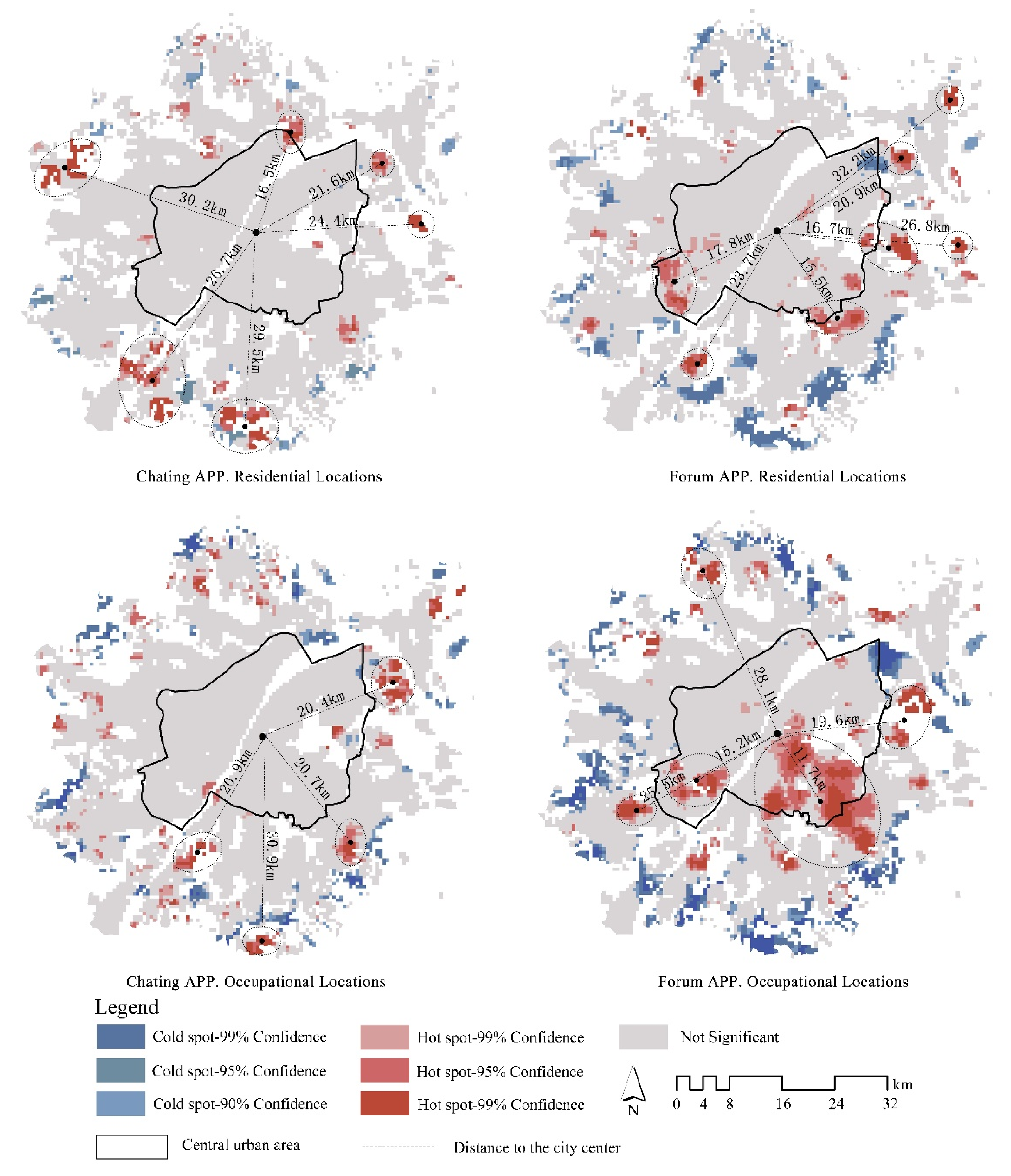


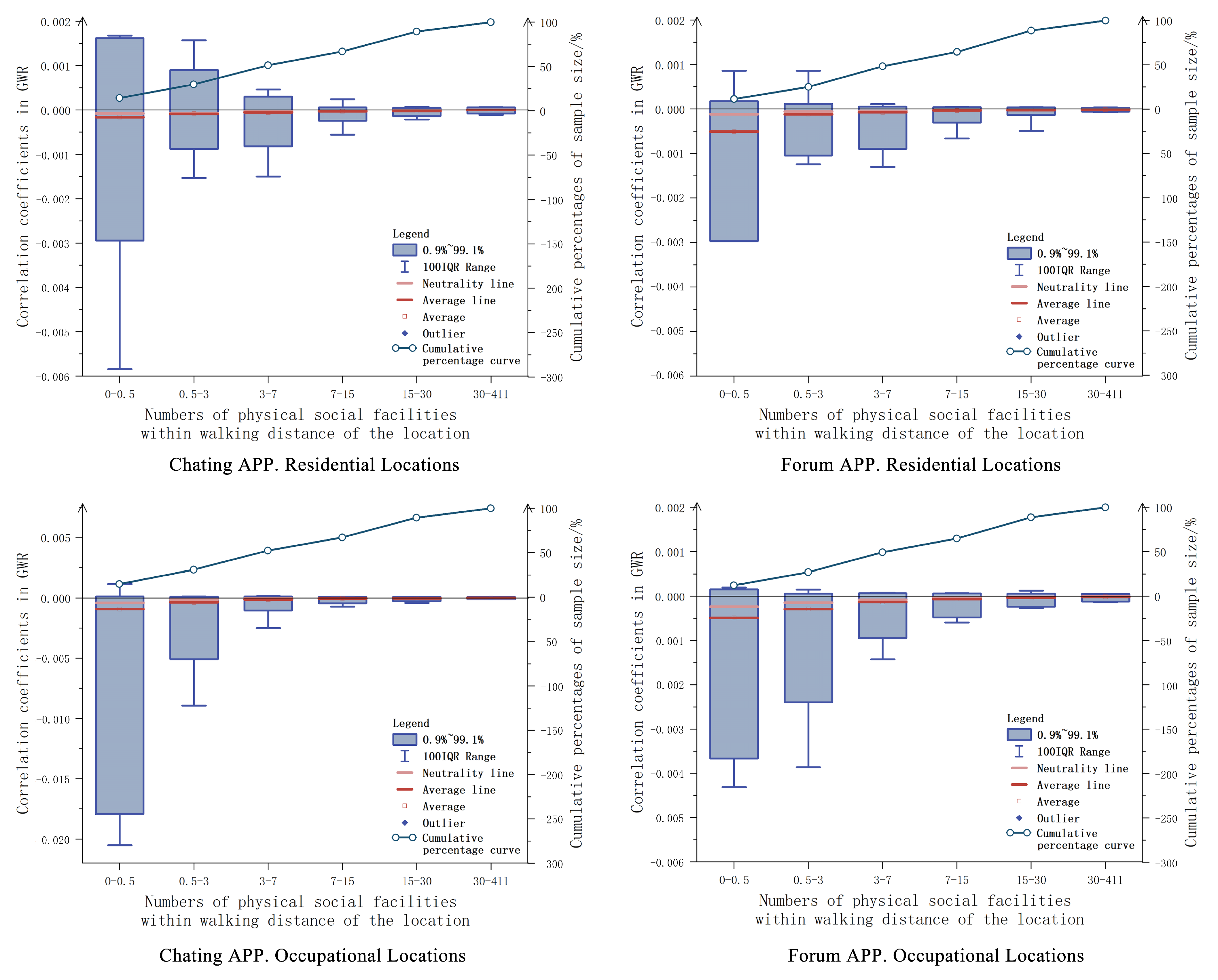
| App Classification | App Names | Number of Users | |
|---|---|---|---|
| Working | Living | ||
| Chatting app | SOUL, Momo, and Tantan | 51,024 | 51,508 |
| Forum app | Baidu Tieba | 39,438 | 39,796 |
| Sum | 90,462 | 91,304 | |
| Classification | POI Name |
|---|---|
| Catering | patisserie, teahouse, bar, and coffee |
| Shopping | shopping centers, department stores, commercial streets, and convenience stores |
| Entertainment | KTV, cinema, chess room, internet cafe, bathing, and massage |
| Park place | community center, square |
| Sports | bowling, squash, ice and snow sports, outdoor fitness places, golf, basketball, fitness center, equestrian and horse racing, water sports, table tennis, billiards, taekwondo, tennis, swimming, badminton, gymnasium, football, museum, exhibition, memorial hall, theater, science and technology museum, art exhibition, aquarium, planetarium, library, cultural palace, botanical garden, zoo, holiday pension, red tourism, scenic spots, farmhouse campground, and playground |
| Variables | Categories | Case | Percentage (%) | ||
|---|---|---|---|---|---|
| Chatting App | Forum App | Chatting App | Forum App | ||
| Gender | Male | 41,116 | 31,833 | 76.20 | 77.18 |
| Female | 11,961 | 8815 | 22.17 | 21.37 | |
| Unknown | 878 | 595 | 1.63 | 1.44 | |
| Age | 18 or below | 1183 | 625 | 2.19 | 1.52 |
| 19–39 | 46,281 | 35,983 | 85.78 | 87.30 | |
| 40–59 | 5094 | 3673 | 9.44 | 8.91 | |
| 60 or above | 530 | 334 | 0.98 | 0.81 | |
| Unknown | 867 | 601 | 1.61 | 1.46 | |
| Residential location | Central urban area | 33,197 | 26,388 | 65.06 | 66.91 |
| Suburb | 17,827 | 13,050 | 34.94 | 33.09 | |
| Working location | Central urban area | 33,343 | 27,173 | 64.73 | 68.28 |
| Suburb | 18,165 | 12,623 | 35.27 | 31.72 | |
| App Classification | Statistical Location | Global Moran’s I Value | Z-Score | p-Value | Confidence Interval |
|---|---|---|---|---|---|
| Chatting app | residential locations | 0.008 | 2.79 | 0.005 | 99% |
| occupational locations | 0.010 | 3.34 | 0.001 | 99% | |
| Forum app | residential locations | 0.025 | 9.04 | 0.000 | 99% |
| occupational locations | 0.047 | 16.28 | 0.000 | 99% |
Disclaimer/Publisher’s Note: The statements, opinions and data contained in all publications are solely those of the individual author(s) and contributor(s) and not of MDPI and/or the editor(s). MDPI and/or the editor(s) disclaim responsibility for any injury to people or property resulting from any ideas, methods, instructions or products referred to in the content. |
© 2023 by the authors. Licensee MDPI, Basel, Switzerland. This article is an open access article distributed under the terms and conditions of the Creative Commons Attribution (CC BY) license (https://creativecommons.org/licenses/by/4.0/).
Share and Cite
Deng, H.; Niu, Q.; Wu, L. Do Locations of Employment and Residence Influence whether People Use Virtual Social Networks? A Case Study of Residents in Wuhan, China. ISPRS Int. J. Geo-Inf. 2023, 12, 410. https://doi.org/10.3390/ijgi12100410
Deng H, Niu Q, Wu L. Do Locations of Employment and Residence Influence whether People Use Virtual Social Networks? A Case Study of Residents in Wuhan, China. ISPRS International Journal of Geo-Information. 2023; 12(10):410. https://doi.org/10.3390/ijgi12100410
Chicago/Turabian StyleDeng, Huixia, Qiang Niu, and Lei Wu. 2023. "Do Locations of Employment and Residence Influence whether People Use Virtual Social Networks? A Case Study of Residents in Wuhan, China" ISPRS International Journal of Geo-Information 12, no. 10: 410. https://doi.org/10.3390/ijgi12100410





